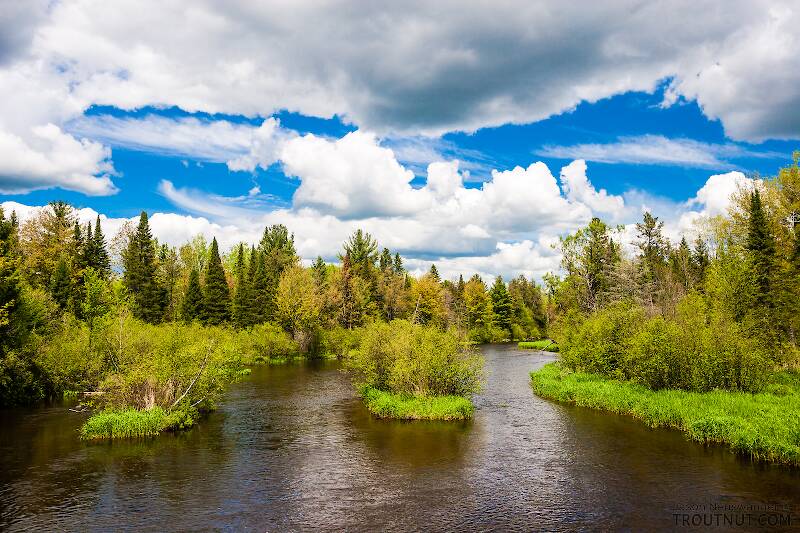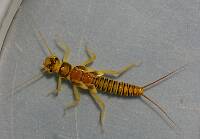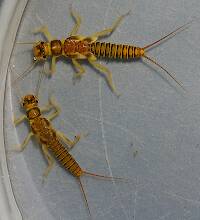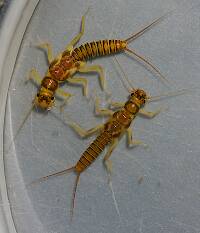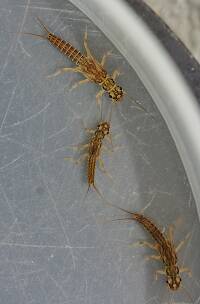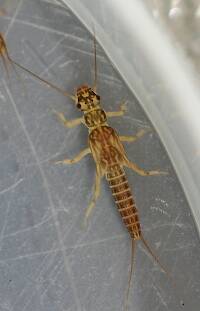
Salmonflies
Pteronarcys californica
The giant Salmonflies of the Western mountains are legendary for their proclivity to elicit consistent dry-fly action and ferocious strikes.
Featured on the forum

Troutnut is a project started in 2003 by salmonid ecologist Jason "Troutnut" Neuswanger to help anglers and
fly tyers unabashedly embrace the entomological side of the sport. Learn more about Troutnut or
support the project for an enhanced experience here.
Gbutler
Posts: 9
Posts: 9
Gbutler on Jul 16, 2007July 16th, 2007, 10:10 am EDT
Being unable to find one, I am trying to construct a dependable hatch chart for these waters. Unfortunately, this is an atypical year (what with the repairs to Wolf Creek Dam) and the water is unusally warm. I have a Tennessee chart, some 75 miles further South and more into the Appalachians, but I think it would be usable. Any ideas out there?
GONZO on Jul 17, 2007July 17th, 2007, 7:15 am EDT
Hi "G,"
My best suggestion would be to get in touch with Brett Billings. He works with the USFWS and is very familiar with the CR tailwater and its hatches. He did post here, but I haven't heard from him in a while. If you'd like, send me a PM, and I'll try to find his contact information for you. (Welcome to the site, by the way.)
Best,
Lloyd
My best suggestion would be to get in touch with Brett Billings. He works with the USFWS and is very familiar with the CR tailwater and its hatches. He did post here, but I haven't heard from him in a while. If you'd like, send me a PM, and I'll try to find his contact information for you. (Welcome to the site, by the way.)
Best,
Lloyd
Gbutler
Posts: 9
Posts: 9
Gbutler on Jul 17, 2007July 17th, 2007, 3:20 pm EDT
Hi Lloyd,
Thanks for the reply. Many people are not aware of the quality of these waters, and the guides who do driftboat trips are more than helpful on their websites, but nobody has posted a hatch chart. As I mentioned things are a bit skewed with the warmer waters, however it semms to me that if one knows the insect species and their respective range of hatch thresholds, one could check the water temps and infer a potential hatch prospect. Sometimes it is difficult to tell what is the hatch of the moment, but midges always work especially Copper Johns. and Tungsten Zebras. I should mention that, in managing these waters, KDFWR elctrofished the waters earlier this year and found Brown Trout that were obviously multi-year survivors and WELL beyond the current State records.
I can be reached here, of course, or at gbutler2003@qx.net. I will try to locate Brett Billings through the USFWS resources as well.
Thanks,
Greg
Thanks for the reply. Many people are not aware of the quality of these waters, and the guides who do driftboat trips are more than helpful on their websites, but nobody has posted a hatch chart. As I mentioned things are a bit skewed with the warmer waters, however it semms to me that if one knows the insect species and their respective range of hatch thresholds, one could check the water temps and infer a potential hatch prospect. Sometimes it is difficult to tell what is the hatch of the moment, but midges always work especially Copper Johns. and Tungsten Zebras. I should mention that, in managing these waters, KDFWR elctrofished the waters earlier this year and found Brown Trout that were obviously multi-year survivors and WELL beyond the current State records.
I can be reached here, of course, or at gbutler2003@qx.net. I will try to locate Brett Billings through the USFWS resources as well.
Thanks,
Greg
GONZO on Jul 17, 2007July 17th, 2007, 4:06 pm EDT
Greg,
Brett told me about the wonderful fishing on the CR. About all I can remember about the hatches is that you have a terrific grannom (Brachycentrus numerosus) hatch. Brett showed me a babyfood jar filled with numerosus pupae that he had collected from the stomach of a single big rainbow from the CR--a very impressive trophy! I'll PM Brett's info to you. I think he was actually working on a book about the CR.
Brett told me about the wonderful fishing on the CR. About all I can remember about the hatches is that you have a terrific grannom (Brachycentrus numerosus) hatch. Brett showed me a babyfood jar filled with numerosus pupae that he had collected from the stomach of a single big rainbow from the CR--a very impressive trophy! I'll PM Brett's info to you. I think he was actually working on a book about the CR.
Gbutler
Posts: 9
Posts: 9
Gbutler on Jul 17, 2007July 17th, 2007, 4:21 pm EDT
Super! Got the info, Lloyd. I'll pass the message along when I contact Brett. Many thanks.
Greg
Greg
Gbutler
Posts: 9
Posts: 9
Gbutler on Jul 17, 2007July 17th, 2007, 5:14 pm EDT
Lloyd,
And you didn't happen to mention Fly-Fishing Pressured Water, because.................?
Greg
And you didn't happen to mention Fly-Fishing Pressured Water, because.................?
Greg
GONZO on Jul 18, 2007July 18th, 2007, 3:33 am EDT
I guess I just didn't see a reason to mention it, Greg.
Gbutler
Posts: 9
Posts: 9
Gbutler on Jul 18, 2007July 18th, 2007, 7:59 am EDT
Lloyd,
Didn't mean to put you off by questioning about your book. Apologize if I did. It is a five-star book on Amazon along with Mercer's Creative Fly-Tying. No small accomplishment! And it happens to have a section with a Centralized Eastern Emergence Table. Is that what I think it is? I know, I have to buy the book in order to find out. :) Ok, I'm going to anyway, partly for the info and partly out of respect for you and your ideas. I would have taken your advice pretty readily if you has mentioned it.
I relayed your message to Brett Billings, and am sure I will appreciate his reply.
Thanks as always for your help and advice.
Greg
Didn't mean to put you off by questioning about your book. Apologize if I did. It is a five-star book on Amazon along with Mercer's Creative Fly-Tying. No small accomplishment! And it happens to have a section with a Centralized Eastern Emergence Table. Is that what I think it is? I know, I have to buy the book in order to find out. :) Ok, I'm going to anyway, partly for the info and partly out of respect for you and your ideas. I would have taken your advice pretty readily if you has mentioned it.
I relayed your message to Brett Billings, and am sure I will appreciate his reply.
Thanks as always for your help and advice.
Greg
GONZO on Jul 18, 2007July 18th, 2007, 10:28 am EDT
Didn't mean to put you off by questioning about your book.
Not at all, Greg. The "Generalized Eastern Emergence Tables" that are included in the book were compiled from more than thirty years of personal notes. Because most of my regular fishing experience is from Southcentral PA to the northern Catskills, the timing I show in the tables splits the geographic difference and is most accurate for the Pocono region of PA. The majority of insects listed are common to most of the East and Midwest, so I suppose it could be adjusted (if you take into account that the largest differences would occur early and late in the season). Of course, not every system or stream has all of the listed insects--though the Delaware River comes pretty close.
I thought you were looking for something more specific to your region, otherwise I might have mentioned it. (Though perhaps not--I've been accused of being a poor salesman.) Anyway, if you think it might be useful, you don't have to buy the whole darn book just to get a couple of pages; I could make a copy of the tables and send them to you.
Troutnut on Jul 18, 2007July 18th, 2007, 12:54 pm EDT
Lloyd knows all kinds of cool stuff that isn't in his book. Of course, there's nothing in the book that I would have him remove to make room, either. The inevitable conclusion is that we should all get together outside his house someday chanting, "sequel! sequel!"
Jason Neuswanger, Ph.D.
Troutnut and salmonid ecologist
Troutnut and salmonid ecologist
Konchu on Jul 18, 2007July 18th, 2007, 3:15 pm EDT
Which are the prevalent Ephemerella on the Cumberland? The majority of nymphs that I saw I called "sp." Has anyone identified adults from there?
Gbutler
Posts: 9
Posts: 9
Gbutler on Jul 19, 2007July 19th, 2007, 2:23 am EDT
Konchu,
I have a message with Brett Billings, referred to me by our guru, Gonzo, on the work he is doing/has done on the CRT. I am about to start on some modest research possibly to include some waterside collection stations (the little cardboard triangles one sometimes see on trees in town) as the authorities will allow me, and to submit some samples to Jason, Taxon, et al for ID. My contact with Brett B. will allow me to not go over ground previously plowed, maybe even augment or enhance. Perhaps I overeach here, but I am looking for answers as are you. I might suggest that you also submit some samples to The Braintrust yourself.
Hope to see you on the CRT sometime. I am the skinny Italian-looking guy with a moustache and pipe whom people usually nickname 'professor' (note small 'p'), and no matter where I am I always hear "you're not from around here, are you?"
I have a message with Brett Billings, referred to me by our guru, Gonzo, on the work he is doing/has done on the CRT. I am about to start on some modest research possibly to include some waterside collection stations (the little cardboard triangles one sometimes see on trees in town) as the authorities will allow me, and to submit some samples to Jason, Taxon, et al for ID. My contact with Brett B. will allow me to not go over ground previously plowed, maybe even augment or enhance. Perhaps I overeach here, but I am looking for answers as are you. I might suggest that you also submit some samples to The Braintrust yourself.
Hope to see you on the CRT sometime. I am the skinny Italian-looking guy with a moustache and pipe whom people usually nickname 'professor' (note small 'p'), and no matter where I am I always hear "you're not from around here, are you?"
Gbutler
Posts: 9
Posts: 9
Gbutler on Jul 19, 2007July 19th, 2007, 2:44 am EDT
"The "Generalized Eastern Emergence Tables" that are included in the book were compiled from more than thirty years of personal notes."
GONZO
Lloyd,
I'm going to get the book for all the reason everyone is already stating. You present ideas ranging from confirmation of theories already proposed, to higher development of current theory and practice, up to the occasional grenade of new thought rolled under the tent of the mind. You see, just like everyone else, we fly-flippers tend to become a little set in our thought patterns, but that doesn't seem to affect you much. Thank God.
The Emergence Tables would be a wonderful template - adjust the Lat. & Long., factor in the differences in sp. and local environment, mix in the work done by Brett B., collect & identify, put things to merciless field test and scrutiny, have great fun and meet fine people while doing so, share the results. Sound like a plan?
Of course I'm going to get the book. How could I miss out on the ideas? Besides, I need that purpose to be amongst the group standing outside your house, 5-6 wts. in hand, shouting "Sequel, Sequel".
Greg
GONZO
Lloyd,
I'm going to get the book for all the reason everyone is already stating. You present ideas ranging from confirmation of theories already proposed, to higher development of current theory and practice, up to the occasional grenade of new thought rolled under the tent of the mind. You see, just like everyone else, we fly-flippers tend to become a little set in our thought patterns, but that doesn't seem to affect you much. Thank God.
The Emergence Tables would be a wonderful template - adjust the Lat. & Long., factor in the differences in sp. and local environment, mix in the work done by Brett B., collect & identify, put things to merciless field test and scrutiny, have great fun and meet fine people while doing so, share the results. Sound like a plan?
Of course I'm going to get the book. How could I miss out on the ideas? Besides, I need that purpose to be amongst the group standing outside your house, 5-6 wts. in hand, shouting "Sequel, Sequel".
Greg
GONZO on Jul 19, 2007July 19th, 2007, 3:38 am EDT
Greg,
Thank you very much. I only hope you find that the book lives up to the hype. I know that the semi-anonymous status that many Troutnut posters maintain can make things a bit mysterious at first, but I love the low-key and friendly way that everyone from novice to professional cooperates on this site. Your post to Konchu makes me think that something of an introduction might be in order. It may help to know that Konchu is a top professional entomologist. (And there are other professional entomologists and biologists lurking in our ranks.)
Best,
Lloyd
Thank you very much. I only hope you find that the book lives up to the hype. I know that the semi-anonymous status that many Troutnut posters maintain can make things a bit mysterious at first, but I love the low-key and friendly way that everyone from novice to professional cooperates on this site. Your post to Konchu makes me think that something of an introduction might be in order. It may help to know that Konchu is a top professional entomologist. (And there are other professional entomologists and biologists lurking in our ranks.)
Best,
Lloyd
Woodster
Posts: 2
Posts: 2
Woodster on May 29, 2008May 29th, 2008, 7:14 am EDT
Here are my observations on Cumberland bugs, gathered coincidentally over the past 25 years.
Midges hatch profusely year-round, most heavily just below the dam, diminishing gradually as you move downriver. Caddis begin showing up a few miles downriver, and can hatch in big numbers between Helm's Landing (5miles) and Burkesville (35 miles) from around Mother's Day until Flag Day. After Flag Day, Caddis hatches are increasingly sporadic until they pretty much disappear by Labor Day. Various broods of Baetis appear from early autumn until late spring, sometimes even into early summer. Size 16 to 20, depending on the brood. They come in waves. Like the Caddis, these bugs are largely absent from the first 5 or so miles of water, and are most numerous from about mile 10 to mile 45. This same stretch of water sees an excellent sulphur hatch beginning late May through July, most years. About a 16 or 18. Some years we will see Caddis, Baetis, Sulphurs and midges in a masking blizzard. At that time, just scream a wooly bugger through the middle of the mess and hope for the best. We also have good numbers of a Giant Stonefly, similar to the Western Salmonfly, Pteronarcys Californicus. Slightly larger, if you can believe that. I'm not sure of its correct taxonomy. However, it is very shy of bright light, hatches exclusively at night, and you never see it on the water in the daytime. So dry fly fishing this hatch is a no go. But all clean gravels have good numbers of the nymph, and the fish will almost always take a well presented heavily weighted black or brown stonefly, size 4 or so. We also see stray singles of a big (sz. 12) white bodied may fly, and when they are out, few fish will refuse your big Light Cahill or a House and Lot. Crayfish are common along the shelf rock ledges on falling water and fish love them. Never fail to fish streamers from a drifting boat. Thats all.
Midges hatch profusely year-round, most heavily just below the dam, diminishing gradually as you move downriver. Caddis begin showing up a few miles downriver, and can hatch in big numbers between Helm's Landing (5miles) and Burkesville (35 miles) from around Mother's Day until Flag Day. After Flag Day, Caddis hatches are increasingly sporadic until they pretty much disappear by Labor Day. Various broods of Baetis appear from early autumn until late spring, sometimes even into early summer. Size 16 to 20, depending on the brood. They come in waves. Like the Caddis, these bugs are largely absent from the first 5 or so miles of water, and are most numerous from about mile 10 to mile 45. This same stretch of water sees an excellent sulphur hatch beginning late May through July, most years. About a 16 or 18. Some years we will see Caddis, Baetis, Sulphurs and midges in a masking blizzard. At that time, just scream a wooly bugger through the middle of the mess and hope for the best. We also have good numbers of a Giant Stonefly, similar to the Western Salmonfly, Pteronarcys Californicus. Slightly larger, if you can believe that. I'm not sure of its correct taxonomy. However, it is very shy of bright light, hatches exclusively at night, and you never see it on the water in the daytime. So dry fly fishing this hatch is a no go. But all clean gravels have good numbers of the nymph, and the fish will almost always take a well presented heavily weighted black or brown stonefly, size 4 or so. We also see stray singles of a big (sz. 12) white bodied may fly, and when they are out, few fish will refuse your big Light Cahill or a House and Lot. Crayfish are common along the shelf rock ledges on falling water and fish love them. Never fail to fish streamers from a drifting boat. Thats all.
Martinlf on May 31, 2008May 31st, 2008, 11:14 am EDT
What a helpful chart for folks down that way.
Guides on the Delaware make special night trips when the big stones are hatching. I've never been, but they say the sound of a huge brown sucking in a big deer hair pattern is heart-stopping.
Guides on the Delaware make special night trips when the big stones are hatching. I've never been, but they say the sound of a huge brown sucking in a big deer hair pattern is heart-stopping.
"He spread them a yard and a half. 'And every one that got away is this big.'"
--Fred Chappell
--Fred Chappell
Konchu on Jun 1, 2008June 1st, 2008, 3:00 pm EDT
That Giant Stonefly might be an Acroneuria sp. There's one that lives near my house, and I've only found adults between 12:00midnite and 12:30.
Woodster
Posts: 2
Posts: 2
Woodster on Jun 2, 2008June 2nd, 2008, 4:40 am EDT
At the moment, we're in the midst of a 17-year Periodical Cicada "hatch". Great swarms of this huge insect are in the trees and droning constantly. A few had begun to land on the water this weekend. Another day or two and all the fish should have their noses glued to the surface.
Yesterday, I was drifting a Pheasant Tail below a big Turk's Tarantula, and several browns absolutely destroyed the Turk's. They must have already tried a "Cicada Sampler". Between the Stoneflies, the Cicadas and the gathering Sulphur hatch , the next three weeks could get real interesting.
Yesterday, I was drifting a Pheasant Tail below a big Turk's Tarantula, and several browns absolutely destroyed the Turk's. They must have already tried a "Cicada Sampler". Between the Stoneflies, the Cicadas and the gathering Sulphur hatch , the next three weeks could get real interesting.
Quick Reply
Related Discussions
Topic
Replies
Last Reply
1
Aug 24, 2006
by Troutnut
by Troutnut
1
Jun 10, 2009
by Martinlf
by Martinlf
4
Jan 19, 2015
by Kschaefer3
by Kschaefer3
4
May 11, 2017
by Millcreek
by Millcreek

